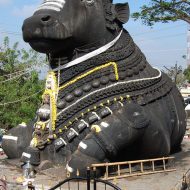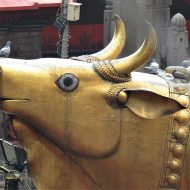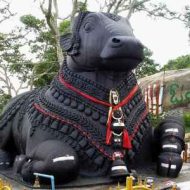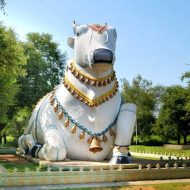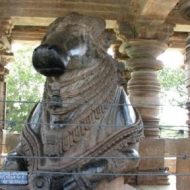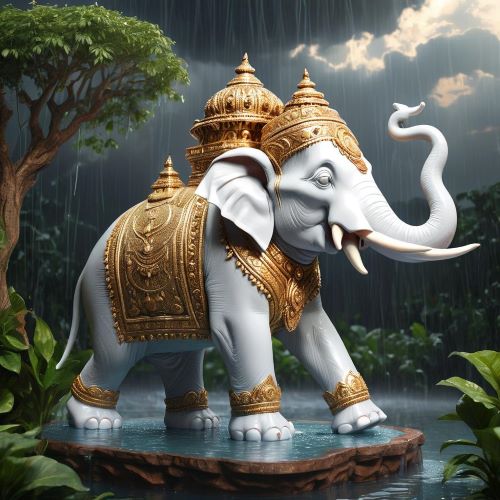Nandi : The Sacred Bull of Strength and Devotion
Listen
At a glance
| Description | |
|---|---|
| Origin | Indian Mythology |
| Classification | Animals |
| Family Members | Silada (Father) |
| Region | India |
| Associated With | Lord Shiva, Protection |
Nandi
Introduction
Nandi stands as one of the most recognizable and revered figures — the divine bull, mount (vahana) and gatekeeper of Lord Shiva. Far more than a sacred animal, Nandi embodies purity, loyalty, and the perfect balance between power and devotion. His name derives from the Sanskrit word ānanda, meaning “bliss,” symbolizing the serene joy of unwavering faith.
Nandi occupies a central place not only in mythology but also in Indian temple architecture and worship. Sitting calmly before every Shiva shrine, he represents both guardian and devotee, watching over the cosmic dance between destruction and creation. To gaze upon Nandi before entering a Shiva temple is to align one’s heart with the virtue of pure devotion — silent, steadfast, and strong.
Physical Traits
Nandi is most often depicted as a majestic white bull, seated in repose yet radiating alert strength. His body gleams with divine energy, representing purity and discipline. The white hue symbolizes both spiritual clarity and detachment — the qualities necessary for a devotee of Shiva. His eyes, large and compassionate, convey unshakeable devotion to his lord, while the ornaments on his neck and horns signify his celestial status.
In iconography, Nandi sits directly facing Shiva’s sanctum (garbhagriha), a posture symbolizing eternal service and contemplation. Artists often portray him adorned with golden bells, sacred threads, and garlands. In ancient texts, Nandi’s voice is said to carry the resonance of thunder, and his presence controls the elemental energies of wind and rain — a reflection of his role as the embodiment of nature’s disciplined force.
Family
The origins of Nandi are deeply rooted in both myth and philosophy. According to Shaiva scriptures, Nandi was born from the union of the sage Shilada and divine blessings from Shiva himself. Shilada, desiring a son who would be immortal and devoted to Shiva, performed intense penance until the god granted his wish. From the sacred fire emerged Nandi — radiant, strong, and already chanting Shiva’s name.
Nandi’s divine family extends into the broader circle of Shiva’s attendants (ganas). He is regarded as the chief of Shiva’s attendants and the leader of his armies, commanding spirits, demi-gods, and celestial beings. In some texts, Nandi is even described as a teacher, imparting spiritual wisdom to sages and devotees, showing that devotion and knowledge can coexist in perfect harmony.
Other Names
Nandi is known by many names that reflect his diverse aspects and significance. As Nandikeshvara, he is the “Lord of Joy.” As Vrishabha, he is identified with the cosmic bull symbolizing dharma — righteousness and moral order. In South Indian Shaivism, he is affectionately called Periya Nandi or Adi Nandi, signifying his primordial nature as the first devotee.
In philosophical contexts, Nandi is also seen as the embodiment of Shiva’s energy in animal form, representing strength directed by wisdom. His name is invoked during rituals, festivals, and even martial ceremonies to symbolize courage guided by faith.
Powers and Abilities
Nandi’s powers are as vast as his devotion. Blessed directly by Shiva, he possesses immense physical strength and control over natural forces. Myths describe Nandi as capable of stopping rivers, lifting mountains, and subduing demons with a single roar. Yet, his might is never reckless — it is the disciplined strength of service and protection.
Spiritually, Nandi is regarded as a guardian of the threshold between the material and the divine. Only those with pure intentions can pass beyond him into Shiva’s abode. His gaze symbolizes the inner eye of discernment, which perceives truth beyond illusion.
In yogic symbolism, Nandi represents the awakened kundalini energy — calm yet infinitely powerful. His posture of meditation mirrors the yogic balance between body and spirit. In the Skanda Purana, Nandi is also credited with imparting the principles of Shiva Yoga, transmitting sacred knowledge to both gods and sages.
Nandi’s devotion itself is considered his greatest power — an example of bhakti (devotion) so pure that it transcends form and ego.
Modern Day Influence
Nandi’s legacy endures across India and beyond, not only as a mythological figure but as a living cultural and spiritual symbol. Almost every Shiva temple features a Nandi statue facing the inner sanctum, where devotees whisper their prayers into his ear before they reach the deity. This practice reflects the belief that Nandi conveys sincere devotion directly to Shiva.
Festivals like Maha Shivaratri celebrate Nandi’s presence as Shiva’s eternal companion. In traditional South Indian temple processions, Nandi is carried with grandeur through the streets, decorated with flowers and silks. The Nandi Hills near Bangalore and the massive Nandi statues of Thanjavur, Mysore, and Lepakshi stand as architectural testaments to his enduring cultural prominence.
Beyond religion, Nandi’s symbolism has entered modern consciousness. He is regarded as a model of loyalty and discipline, qualities valued in both personal and professional life. For spiritual seekers, Nandi embodies the path of service — where strength is tempered by humility, and power is guided by love.
Today, Nandi’s image transcends borders, inspiring art, literature, and even contemporary wellness philosophy. To meditate on Nandi is to remember that the truest strength lies not in domination, but in devotion.
Related Images
Source
Basham, A. L. (1954). The Wonder That Was India. Grove Press.
Kinsley, D. (1988). Hindu Goddesses and Gods: Visions of the Divine Feminine. University of California Press.
Klostermaier, K. K. (2007). A Survey of Hinduism. State University of New York Press.
Narayanan, V. (2003). The Life of Hinduism. University of California Press.
Wikipedia contributors. (n.d.). Nandi (bull). In Wikipedia, The Free Encyclopedia. https://en.wikipedia.org/wiki/Nandi_(bull)
LearnReligions. (2023). Nandi: The Sacred Bull of Lord Shiva. https://www.learnreligions.com/nandi-the-sacred-bull-177041
IndiaNetzone. (2022). Nandi: The Divine Vehicle of Lord Shiva. https://www.indianetzone.com/22/nandi_vehicle_lord_shiva.htm
AncientPages.com. (2021). Nandi – The Sacred Bull and Loyal Companion of Shiva. https://www.ancientpages.com/2021/05/07/nandi-the-sacred-bull/
Frequently Asked Questions
Is Nandi a cow or bull?
Nandi, the revered figure in Hindu mythology, is not a cow, but a bull: a male bovine symbolizing strength, fertility, and righteousness. He is the loyal companion and vehicle of the god Shiva, ever present in Shiva temples across the globe as a seated figure with horns, a hump, and a dewlap. While referred to as a “sacred bull” or “the bull of Shiva,” Nandi’s significance lies in his male identity and the symbolic meaning he embodies.
What is the role of Nandi?
More than just Shiva’s majestic mount, Nandi embodies a tapestry of roles in Hinduism. He stands as a devoted gatekeeper guarding the entrance to Shiva’s sanctum, a constant devotee offering unwavering focus and surrender, and a symbol of strength, determination, and focused concentration. He is the granter of boons to those who seek his blessings and a potent reminder of the importance of single-pointed devotion on the spiritual path.
What does the Nandi symbolize?
Nandi, the revered bull of Shiva, is much more than just a divine mount. He embodies a wealth of virtues and spiritual aspirations. His strength and virility inspire action, his horns represent righteousness, and his hump symbolizes potential. His unwavering gaze towards Shiva illustrates devotion and focus, while his stillness signifies the importance of patience and receptivity. He even grants blessings to those who sincerely seek them. Thus, Nandi transcends his physical form to become a powerful guide, reminding us to cultivate inner strength, unwavering devotion, and focused concentration on our journey towards enlightenment.
Why Nandi is so powerful?
Nandi’s power lies not in brute strength, but in a confluence of divine connection, unwavering devotion, and symbolic significance. As Lord Shiva’s chosen mount, he carries a portion of Shiva’s immense power. His horns represent righteousness, his hump signifies wisdom, and his dewlap overflows with blessings. Guarding Shiva’s sanctum and granting boons to devotees, Nandi embodies the ideal of focused concentration and unwavering devotion, making him a powerful guide on the spiritual path.
Why Nandi looks at Shiva?
Nandi’s unwavering gaze at Shiva isn’t a mere physical act; it’s a multifaceted expression of his profound devotion, yearning for knowledge, role as protector, and embodiment of focused meditation. By constantly focusing on Shiva, he inspires devotees to cultivate similar dedication, seek spiritual growth, maintain inner purity, be mindful of the divine, and achieve the ideal state of focused concentration on the path to enlightenment.


